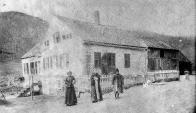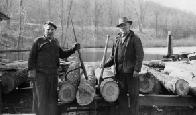
William C. Sharpe published this photo of Washburn Falls in the early 1900's. The Falls was on Little River, near Victory Memorial Park. In the 1800's, Lewellyn Andrews operated both a sawmill and a grist mill here; nearby Orrin Tucker opened a doughnut factory. (Photo from Images of America, Oxford)

A. B. Hinman was the town tax collector and he operated a tannery on Little River. He would accept payment of taxes in either cash or in animal hides.
(Photo from Oxford Record, D. A. DeBisschop collection)

Roswell Cable was born in Monroe and came to Oxford about 1818. He was a hatter by trade, and built a hat factory on Chestnut Tree Hill, using locally produced and milled wool.
(Photo from Audrey C. Linke)

Map detail from the Beers map of Oxford in 1868, which shows the many mills located along the Little River. (Full color map of entire town of Oxford available for $5 from Oxford Historical Society at Town Clerk's office.)

Chestnut Trees provided income to landowners and mill operators who provided the valuable wood for New York shipbuilders and barrel makers of the West Indies trade. This Chestnut tree stood on Rimmon Hill in what is now Seymour, but much of its life was in Oxford. No, the tree did not move; Oxford shrank when Seymour was formed. In 1902, the tree's circumference was 26 feet. (Photo from Images of America, Oxford / Image from Seymour Past and Present, William C. Sharpe, 1902)

Oxford's early agriculture and industry were given a boost by the importation of Merino sheep. In 1837 there were 2,965 sheep in Oxford -- nearly two sheep per person. The Merinos provide a thick coat of long wool fibers, as well as more meat than was produced by the smaller sheep that the New England farmers brought with them from England. Sheep farming declined in Oxford due to damage by roaming dogs during the early 1900's. (Photo from Images of America, Oxford / Photo courtesy of Mrs. Carleton Atwater.)

General David Humphreys (right) aide to General Washington, imported Merinos to this country. The improved wool production from the introduction of the breed gave impetus to the development of mills to process the wool. Carding mills, fulling mills, clothiers shops, and hat factories all developed in Oxford. (Photo from Images of America, Oxford)

Cider Press from the Old Park Road Mill. The mill remains as a National Historic Site, but the cider mill equipment is no longer there. (Photo from Evelyn McCarthy)

Henry Gilbert, left, assists Joseph Montriski as the pair moves a log into the mill for cutting.
(Photo by Thomas R. Goodman, courtesy of Evelyn Montriski McCarthy.)

Park Road Mill in 1910. Presently on the National Register of Historic Sites. The Park Road Mill was powered by water released from this dam, which was built without cement. The curved stone dam created a two-acre millpond.. (Photo from collection of William Emerson, owner of the Park Road Mill)

Joseph. Montriski, above, operated the Park Road Mill as a contract sawyer, sawing other people's logs into lumber and charging a fee for his work. For local landowners with standing timber, it was a cheap source of lumber. In 1837 there were 19 mills operating in Oxford. In 1933 there were only two, and by 1950, only this mill remained. (Photo from Images of America, Oxford / Photo by Thomas R. Goodman, courtesy of Evelyn Montriski McCarthy.)

Joseph Montriski's mill cut lumber for local landowners who hauled their logs to the mill. On the left is Wasail Barna, who was Mr. Montriski's help and lived at the mill. Montriski is on the right. The mill, which was operating prior to 1749, is now owned by William Emerson and is on the National Registry of Historic Sites. (Photo from Images of America, Oxford / Photo by Thomas R. Goodman, courtesy of Evelyn Montriski McCarthy.)